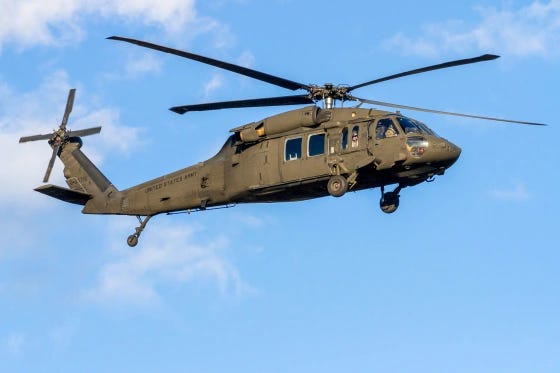Investigation into Fatal Midair Collision Focuses on Helicopter Flight Path
Experts Point to Helicopter's Altitude and Internal Factors as Key to Understanding the Deadly Crash
As federal authorities continue to investigate the deadliest U.S. air crash in nearly 25 years, experts believe the key to understanding the disaster lies in what occurred inside the Army Black Hawk helicopter and the altitude at which it was flying when it collided with a passenger jet. Aviation specialists argue that this crucial information will likely be central to uncovering the cause of the crash.
The tragedy occurred during a routine training mission on Wednesday, involving a pair of seasoned Army pilots and a third aviator, conducted in clear weather. The flight was part of an annual evaluation to assess the pilots’ proficiency. The path taken by the helicopter was familiar to them, as military helicopters often fly over the Washington, D.C., area. Despite these elements, the flight ended tragically when the UH-60 Black Hawk collided with a commercial airliner, resulting in a massive fireball in the sky. The crash claimed the lives of all 64 people aboard the American Eagle flight, with no survivors.
Preliminary data analyzed by NBC News suggests the Army helicopter may have been flying at an unsafe altitude during the collision, although investigators caution against drawing definitive conclusions before reviewing the official flight data. The black boxes from both the passenger jet and the helicopter have been recovered, and they will provide critical information, including the exact altitude at the time of impact.
Jonathan Koziol, a senior Army aviation adviser assisting with the investigation, emphasized that the only “truth” would come from the black box data, and further insights could take time to emerge.
The two aircraft were in transition at the time of the crash, with the American Eagle jet descending toward Ronald Reagan Washington National Airport and the Army helicopter changing its flight path, a common maneuver in the busy airspace above the capital. The last known altitude of the commercial jet was recorded at 375 feet, according to FlightAware. However, Federal Aviation Administration (FAA) regulations typically prohibit helicopters from flying above 200 feet near the airport.
Aviation attorney Tim Loranger, who reviewed the publicly available data, argued that the commercial jet appeared to be operating within its proper altitude range, while the Army helicopter may have been out of compliance. If this is confirmed by the official flight data, questions will arise about potential mechanical issues with the helicopter, whether the pilots received accurate altitude data, and if air traffic control had noted the discrepancy and communicated it to the helicopter crew.
Loranger also questioned whether the Army pilots had maintained enough flight hours to remain proficient. He noted that continuous flying is crucial for maintaining sharp skills, particularly in a high-stakes environment like military aviation.
Koziol stated that the instructor pilot on the Black Hawk had approximately 1,000 flight hours, while the co-pilot, undergoing evaluation, had about 500 hours—an experienced crew by military standards. The Army has identified two of the three crew members: Staff Sgt. Ryan Austin O'Hara, 28, from Lilburn, Georgia, and Chief Warrant Officer 2 Andrew Loyd Eaves, 39, from Great Mills, Maryland. Their remains have not yet been recovered, and the body of O'Hara is pending positive identification.
The National Transportation Safety Board (NTSB), which is leading the investigation, is examining both aircraft’s flight paths and air traffic control operations. Investigators have also scrutinized an air traffic control decision at Reagan National Airport, where a supervisor allowed a controller to end their shift early. This left a single controller managing both the plane and helicopter traffic, an arrangement permitted by FAA regulations but considered atypical during high-traffic times.
Further concerns are being raised about the crowded airspace above Washington, D.C., as Reagan National Airport, originally designed to accommodate 15 million passengers annually, now handles approximately 25 million people each year. This surge in air traffic has sparked discussions about its impact on air traffic safety.
While risks are inherent in military aviation, especially during combat and rescue operations, some experts suggest that training flights have become increasingly hazardous in recent years. The Army recorded its highest number of serious aviation accidents in a decade during fiscal year 2024, including one involving a Black Hawk.
The use of night-vision goggles by the Black Hawk pilots remains unclear, though Defense Secretary Pete Hegseth indicated in a video that the pilots had them. Some experts believe the goggles could have hindered the pilots' visibility in the brightly lit, congested airspace, while others argue that the goggles are invaluable tools for navigating at night.
Amid the investigation, some officials are questioning the suitability of conducting military training near a busy airport. Daniel Driscoll, President Donald Trump’s nominee to lead the U.S. Army, expressed at his Senate confirmation hearing that he plans to review military training protocols, particularly regarding risk assessment near airports like Reagan National.
The Black Hawk involved in the crash was from the Army’s Bravo Company, 12th Aviation Battalion, based at Fort Belvoir, Virginia, a unit tasked with flying senior government officials in and out of Washington, D.C. Koziol emphasized that proficiency in navigating the capital’s airspace is vital for such missions.
Rodney Sangsland, a retired Black Hawk pilot, cautioned against speculation about the cause of the crash but stressed the importance of flying such critical missions over D.C. “That mission requires helicopters to fly that route,” he said. “If you’re going to fly that route, where else can you train?”


